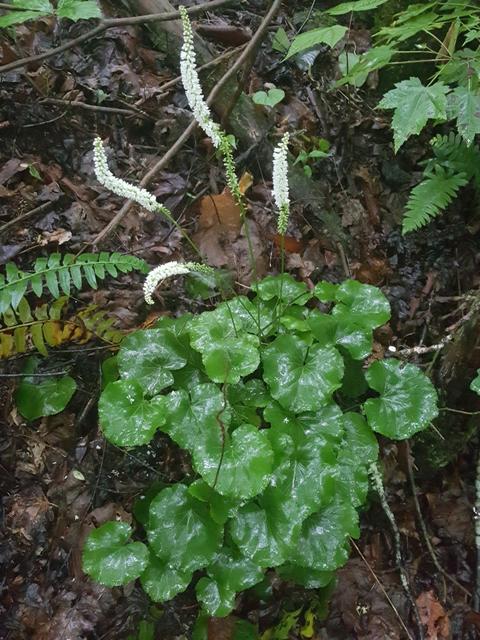A False Recovery, But North Carolina's Ecoregions are Complete!
June 9th, 2020 by Alex Zorach
Unfortunately, shortly after my last post about recovery from COVID-19, I had a relapse, and my recovery from this turned out to be much slower and more irregular than the first time around. Initially, this relapse was scary and confusing because I had not ready any accounts of people with similar experiences. However, it is now clear that a certain portion of people have illnesses that drag on for weeks or even a few months, with recurring, sometimes bizarre symptoms.There has now been some media coverage of people with experiences similar to mine, such as this article on people who have COVID-19 symptoms for months in The Guardian, and an article about patients experiencing relapses of COVID-19 symptoms in Vox.
I have still been working on the site off and on, but, as before, have been neglecting the social media presence and blog updates. I am finally feeling mostly better again, and I'm hoping that this time I will be able to get back to my usual level of work without any further setbacks.
I also want to highlight some of the work I did get done over the past couple months.
Some Excitement About North Carolina
Ecoregion articles are now finished for North Carolina and I have begun adding images for many of them. North Carolina is a fascinating state with respect to ecology and plant diversity. It contains the highest-elevation parts of the southern Appalachians, and thus is home to many northerly plant species that reach the southern limits of their range, such as the red spruce (Picea rubens) at the highest elevations, or yellow birch (Betula alleghaniensis) at slightly lower ones. These are in turn part of forest communities that in many ways resemble more northerly forest types.Farther east, the state also has vast expanses of swamps, peatlands, flatwoods, and coastal wetlands and barrier islands, each of which supports its own unique plant communities. It is also geologically diverse, and the diversity of terrain and soil types further drives plant diversity.
You can explore the map here:
We also published a page on beetleweed (Galax urceolata), an herbaceous plant that is most common in the southern Appalachians, that many people may be familiar with due to its widespread use in flower arrangements, a practice that can sometimes threaten wild populations of this plant.
Enjoy, and hopefully, stay tuned for more active social media postings again!
Archive of All Blogs
The Bias Against Tall Plants, November 11th, 2025
A Focus on Goldenrods (Solidago sp.), July 23rd, 2025
Disturbance and its Role in Plant Habitat Preferences, May 29th, 2025
What "Native" or "Introduced" Mean: Myths and Misconceptions, March 11th, 2025
Smarter & More Informative Search Results, January 13th, 2025
The Effect of the 2024 US Election on Plant Biodiversity and bplant.org, October 30th, 2024
The Problems With Nursery-Bought Plants, And The Solutions, October 8th, 2024
More Databases Linked & Search Improvements for Scientific Names, July 9th, 2024
Choosing The Best Common Names For Plants: Challenges & Solutions, April 19th, 2024
Range Map & Taxonomic Update Progress, January 31st, 2024
Giving Thanks To Everyone We Rely On, November 22nd, 2023
Thinking More Deeply About Habitat, April 5th, 2023
2022 Year-End Summary: Successes & New Goals, February 15th, 2023
New Databases Linked: Flora of North America & NatureServe Explorer, November 11th, 2022
All Range Maps 2nd Generation, Taxonomic Updates, & Fundraising Goal Met!, September 29th, 2022
More Range Map Improvements, POWO Interlinking, And Notes Fields, June 7th, 2022
Ecoregion-Based Plant Lists and Search, March 30th, 2022
Progress Updates on Range Maps and More, February 10th, 2022
The Vision for bplant.org, December 9th, 2021
New Server: Software & Hardware, August 30th, 2021
More & Improved Plant Range Maps, July 19th, 2021
A Control Section for Invasive Plants, April 15th, 2021
Progress Bars & State Ecoregion Legends, March 11th, 2021
Our 2020 Achievements, February 9th, 2021
Interlinking Databases for Plant Research, November 11th, 2020
A New Homepage, Highlighting Our Articles, July 29th, 2020
A False Recovery, But North Carolina's Ecoregions are Complete!, June 9th, 2020
We're Back After COVID-19 Setbacks, April 3rd, 2020
Help Us Find Ecoregion Photos, February 27th, 2020
What We Achieved in 2019, December 30th, 2019
Plant Comparison and ID Guides, October 30th, 2019
We Are Now Accepting Donations, October 14th, 2019
US State Ecoregion Maps, New Footer, Ecoregion Article Progress, and References, September 19th, 2019
Tentative Range Maps of Native Plants, August 12th, 2019
Ecoregion Locator and Interactive Maps, July 10th, 2019
Using Ecoregions Over Political Boundaries, May 13th, 2019
How We Handle Wild vs Cultivated Plants, April 16th, 2019
A Blog To Keep People Updated On Our Progress, April 8th, 2019
Sign Up
Want to get notified of our progress? Sign up for the bplant.org interest list!



